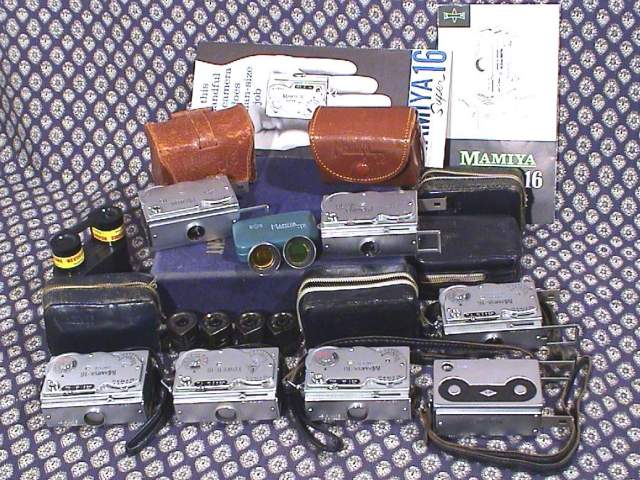introduction | 16 cameras | 16 | 16 Police | 16 Black | Super 16 | Super II | Super III | Tower 16 | Automatic | Revue 16 Automatic | 16 Delux | 16 EE
The first Mamiya subminiature introduced in 1949 had a fixed focus lens and shutter speeds of B, 1/100, 1/50 and 1/25. It came with two close up lenses and two filters that slid onto the front of the lens. The viewfinder popped out of one end and uncovered the lens at the same time. Originally designed to use two cassettes, but the later single-piece cassette will work as well.
The camera is tiny, a diminutive 65x45x32mm (2 9/16 x 1 3/4 x 1 3/16 inches) and only 170g (6.25oz).
The shutter does not fire unless the pull out viewfinder frame is extended. The shutter is locked when the viewfinder is retracted to prevent accidental exposures when carrying the camera.
A black model was also made for the Police shortly and has a detachable right angle view finder and a version sold to the general public in a black hammertone finish.
The Mamiya Super 16 was introduced in 1950. This model has a focusing lens controlled by a sliding bar on the top of the camera. Parallax scale is marked 1Ft or 0.3M. The shutter speed increased with markings of B, 1/2. 1/5, 1/10, 1/25, 1/50, 1/100 and 1/200 s and it has a slot to load the filter. Early versions are engraved "Made in Occupied Japan". Later versions include the small window showing a pattern that moves when the film is advanced. This does not work on the later single piece cassette where the film is not loaded on a spool.
The Mamiya 16 Super II was launched in 1957. Engraved Mamiya 16 Super, to the Super 16 was added a film type reminder and focus scale insert of silver letters on black background. This allowed a lower cost for separate metric and imperial scale. Parallax scale is marked 1Ft and 0.3M. The aperture scale is all marked. Serial numbers are seen on some cameras.
The Mamiya 16 Super Model III in was launched in 1959. Engraved Mamiya 16 Super Model III and inside the film chamber the white arrow indicating the direction of the film path changed to a bright yellow. The front is no longer engraved "Lens:Cute". These cameras are also engraved with a serial number. In other respects this is the same as the Model II.

A version of the Mamiya Super Model III was marketed by Sears Roebuck and Company. It is engraved Tower
Last Updated on 20th August 2002